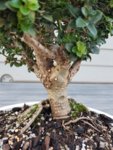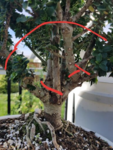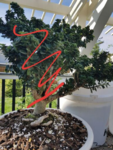amatbrewer
Shohin
I picked up a ILEX CRENATA ‘DWARF PAGODA’ from a local nursery. I am sure I payed way too much but I like the compact leaves, thick trunk, and roots. Worst case I figure it will make a nice accent plant.
It was very root bound so I re-potted it into a colander and cleaned it up a bit so I could get a better view of what I had purchased. I sealed some of the cuts and left some of the others to see how well it heals cuts first hand. Obvious I will be doing nothing more to it until spring.
I know it is slow growing (2-4" a year), hardened branches are difficult to bend, and it is plenty hearty for my climate. I also read "Softwood cuttings from the current year's growth will root fairly easily when taken in late summer or early fall." and I tried starting a few of the branches I removed during cleaning and the soft wood cuttings seem to be OK, but the one hardwood cutting started dyeing soon after removal. So that seems accurate.
Beyond needing to cut it way back (spring), reduce the number of branches (not sure which yet) and probably address the reverse taper (kind of visible in the last image), I am not sure what to do with it. Any suggestions as to what I might be able to do with it would be appreciated (I really suck at seeing the potential in raw material).





It was very root bound so I re-potted it into a colander and cleaned it up a bit so I could get a better view of what I had purchased. I sealed some of the cuts and left some of the others to see how well it heals cuts first hand. Obvious I will be doing nothing more to it until spring.
I know it is slow growing (2-4" a year), hardened branches are difficult to bend, and it is plenty hearty for my climate. I also read "Softwood cuttings from the current year's growth will root fairly easily when taken in late summer or early fall." and I tried starting a few of the branches I removed during cleaning and the soft wood cuttings seem to be OK, but the one hardwood cutting started dyeing soon after removal. So that seems accurate.
Beyond needing to cut it way back (spring), reduce the number of branches (not sure which yet) and probably address the reverse taper (kind of visible in the last image), I am not sure what to do with it. Any suggestions as to what I might be able to do with it would be appreciated (I really suck at seeing the potential in raw material).








